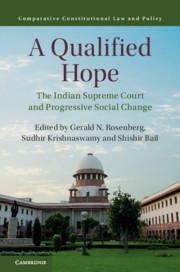Book contents
- A Qualified Hope
- Comparative Constitutional Law and Policy
- A Qualified Hope
- Copyright page
- Contents
- Notes on Contributors
- Foreword
- Acknowledgments
- Introduction
- Part I The Supreme Court of India – An Institutional Overview
- 1 The Structure and Functioning of the Supreme Court of India
- 2 The Supreme Court of India
- 3 The Recent Evolution of Public Interest Litigation in the Indian Supreme Court
- 4 Suo Motu Intervention and the Indian Judiciary
- 5 Public Trust in the Indian Judiciary
- Part II The Supreme Court of India, Social and Political Mobilization
- Part III Welfare Rights and the Environment
- Part IV Discrimination
- Conclusion
- References
2 - The Supreme Court of India
An Empirical Overview of the Institution
from Part I - The Supreme Court of India – An Institutional Overview
Published online by Cambridge University Press: 19 August 2019
- A Qualified Hope
- Comparative Constitutional Law and Policy
- A Qualified Hope
- Copyright page
- Contents
- Notes on Contributors
- Foreword
- Acknowledgments
- Introduction
- Part I The Supreme Court of India – An Institutional Overview
- 1 The Structure and Functioning of the Supreme Court of India
- 2 The Supreme Court of India
- 3 The Recent Evolution of Public Interest Litigation in the Indian Supreme Court
- 4 Suo Motu Intervention and the Indian Judiciary
- 5 Public Trust in the Indian Judiciary
- Part II The Supreme Court of India, Social and Political Mobilization
- Part III Welfare Rights and the Environment
- Part IV Discrimination
- Conclusion
- References
Summary
The Indian Supreme Court has been called “the most powerful court in the world” for its wide jurisdiction, its expansive understanding of its own powers, and the billion plus people under its authority. Yet scholars and policy makers have a very uneven picture of the court’s functioning: deep knowledge about the more visible, “high-profile” cases but very little about more mundane, but far more numerous and potentially equally important, decisions. This chapter aims to address this imbalance with a rigorous, empirical account of the Court’s decisions from 2010 to 2015. We use the most extensive original dataset of Indian Supreme Court opinions yet created to provide a broad, quantitative overview of the social identity of the litigants that approach the court, the types of matters they bring to the court, the levels of success that different groups of litigants have before the Court, and the opinion-writing patterns of the various judges of the Supreme Court. This analysis provides foundational facts for the study of the Court and its role in progressive social change.
- Type
- Chapter
- Information
- A Qualified HopeThe Indian Supreme Court and Progressive Social Change, pp. 43 - 76Publisher: Cambridge University PressPrint publication year: 2019
References
- 2
- Cited by

